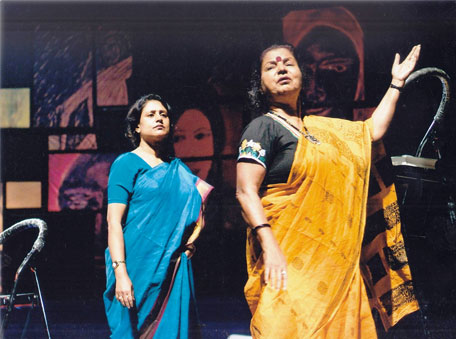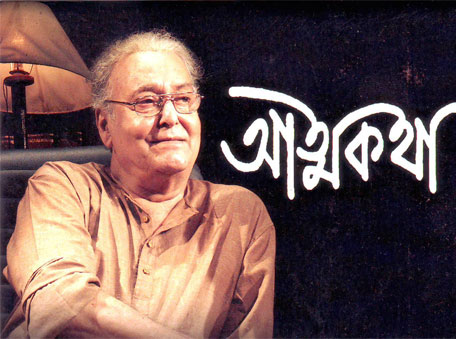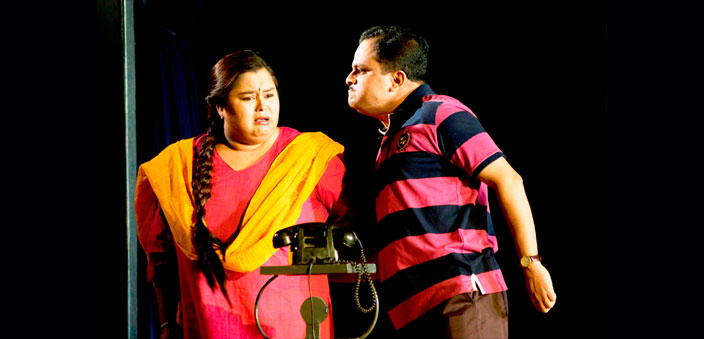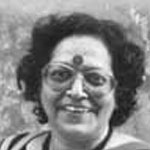Contemporary” is a very significant adjective to qualify Bengali theatre because this theatre has evolved enormously over time and space. The acting has changed from theatrical mannerisms to natural acting brought into vogue by theatre stalwarts like SombhuMitra and Manoj Mitra, among others. Subjects chosen have expanded the parameters of theatre, creating distinct genres from biographies to history through political plays with clear leanings towards the Left, famous literary works, translations and adaptations of internationally renowned playwrights from Shakespeare to Bertole Brecht, and so on. So has the platform extended from the proscenium and the jatra – theatre on the round popular in the small towns and villages, to street theatre performed anywhere and everywhere which was created mainly by the Indian People’s Theatre Association to use theatre to raise awareness among the audience on the fact that India was under the colonial rule of the British. Today, street performances are very popular for their easy accessibility and performances, mostly without an entry fee. The jatra is now called the “One-Wall Theatre” and it has been glamourised by including film stars among the cast that draws a huge audience with repeated encores after each show. It also draws in a good revenue in terms of ticket money so during winter months, One-Wall Theatre rules the roost.
The manner of performance and presentation has also changed radically where some theatre groups focus on the entire body as the medium of expression, some stick to conventional acting modes, while many bring it down to simpler strategies to address every kind of audience. The technicality has changed with brilliant light effects introduced by stalwarts like the late Tapas Sen, who reportedly lighted up the stage that created the effect of a river on the stage for the play Titash, and in another play, he created lighting to produce the effect of a coal mine on stage.
The influencers
Costume dramas are not as popular as they once were except for the works of Rabindranath Tagore, whose plays remain both a hot favourite and a challenge for most theatre groups and personalities. Contemporary politics has also been dealt with by the younger theatre personalities like Saoli Mitra, daughter of the late Sombu Mitra, and Koushik Sen, son of veteran actress Gita Sen. Now, his son is also into theatre and films in a big way. Koushik Sen’s group ‘Swapna Sandhani’ has presented the theatre loving audience in Kolkata and beyond with many wonderful plays over the 30 years of its existence.

Few outside West Bengal know that Dadasaheb Phalke winner Soumitra Chatterjee is not only an outstanding performing artiste who has portrayed different characters in 14 films of Satyajit Ray, or has acted in around 300 films over his more than 50-year-old career in films, but has also contributed to the public theatre in West Bengal like few have in contemporary times.
He has directed and acted in more than a dozen plays and according to director-actor Meghnad Bhattacharya, “is the only public theatre director whose innovative planning for stage production and his thought-provoking style of presenting different sequences on the stage hardly has any difference with the group theatre director’s mode of working. He has given public theatre a completely different look from many standpoints. His plays focus on contemporary life mixed with crisis and confrontation.” His first play was Mukhosh, the Bengali adaptation of W.W. Jacob’s The Monkey’s Paw, which he directed while doing his Masters at Calcutta University. The play won the first prize at the Inter-University Drama Contest in Delhi in 1956. He met Ahindra Choudhury, a great name on Bengali stage, who was invited to polish the work of student actors. Chatterjee requested the great lighting master, the late Tapas Sen to create and orchestrate the lighting for the play.
“Acting in theatre is acting in real time. It is continuous, sequential and chronological. The rehearsals for a play take care of the actor’s preparation for his role. The response too, is immediate. Cinema however, is not acting in real time. It is discontinuous, not sequential and not chronological either. There are no rehearsals for cinema. So, it is very important that the actor prepares for his role through discussions with the director, by reading and re-reading the draft of the script,” explains Chatterjee. Chatterjee also acted in and directed Atmakatha (1988), the Bengali translation of Mahesh Elkunchwar’s original Marathi play. Twenty years later, it remains timeless. Elkunchwar is an influential figure in contemporary Indian theatre for three decades.
Vijay Tendulkar is not often seen in Bengali translations in Kolkata. Recently, Ballygunge Swapnasuchana staged a Bengali translation of Tendulkar’s Kanyadaan. Written in 1983, Kanyadaan is as topical as it was when Tendulkar wrote it. Nath Deolalkar (Meghnath Bhattacharya) and his wife Seva (Swatilekha Sengupta) have worked hard to destroy casteism in principle, in practice and in real life. Their daughter Jyoti’s (Sohini Sengupta) choice of the young and budding poet Arun Athole (Bratya Basu) who is a Dalit, comes like an answer to Nath to prove his ideology of a casteless society. Seva and Jyoti’s brother Jyotiprakash (Bijoy Mukherjee), have reservations about Jyoti’s choice. Their objections are overruled by Nath and Jyoti, who puts her foot down for the first time in her life. Director Bratya Basu’s brilliant exposition illustrates with great conviction that Kanyadaan is about exploitation in varied manifestations.
Rangakarmee, a theatre group founded and directed by Usha Ganguly, specialised in presenting Hindi theatre in Kolkata for many years. But it stepped into Bengali with Manasi, which brought out four notable women from Tagore’s works. Directed, conceived and created by Usha Ganguli, Manasi contemporises the women instead of presenting period pieces as they exist in Tagore’s original works. The curtain goes up to reveal four or five women of different ages collected to rehearse a play based on a Tagore literary piece. Dipti (Usha Ganguly) is the director of the play. Frustrated by the absence of the lead actress, the others begin to rehearse their play with another actress standing in for the absentee. But as the rehearsal proceeds, the actress slips in and out of the character she is to portray, without really being aware of what she is doing. This unwitting mingling between the real and the fictional not only surprises the other women, but also makes them react in the way Indrani does. They keep switching from one Tagore character to another, from Ela of Chaar Adhyay to Kumudini of Jogajog, Sudarshana and Surangama of Raja and Mrinalini of Streer Patra. The actresses keep flashing back and forth between the tragedies of each of Tagore’s women characters and the tragedy of their personal lives filled with stories of domestic violence, desertion by the husband, insecurities stemming from the wife’s success on stage and so on till the differences between the real women and the characters they are rehearsing blur beyond recognition. The five women of different ages relive their personal lives with each play they begin to rehearse, while the others console the one who breaks down from time to time.

Nandikar, founded by Rudraprasad Sengupta and later joined by wife Swatilekha Sengupta now practically run by their daughter Sohini Sengupta, began with adaptations of great playwrights from abroad, and also ventured in tales from the classics and the Vedas. Nandikar is also known for hosting and organising a National Theatre Festival every year in Kolkata, drawing the best of stage talent from across the country and even from neighbouring Pakistan and Bangladesh. Swatilekha is an active actress, music-director and occasional director of this group.
Shanu Roy Chowdhury, the one-woman play Swatilekha Sengupta performs to packed audiences in Kolkata, is like the realisation of a dream, the culmination of two decades of dedicated and committed theatre. Having performed in many productions of Nandikar like The Caucasian Chalk Circle, Football, Nagar Keertan and Shesh Shakshatkar (adapted from The Last Appointment) and directed some of its offbeat productions, Swatilekha seems to have finally found her own mettle in a production like Shanu Roy Chowdhury. Inspired by and adapted from a Willy Russell play called Shirley Valentine, the play opens on a woman, 42-year-old Shanu Roy Chowdhury. She has two grown-up children who have moved away from home, and a husband who wants his dinner served just so.
Sayak, a group founded by Meghnad Bhattacharya has been giving us plays for the past three decades and is still going strong. His son Sayandeb has started his own group to produce and direct new plays: Passing Show is Sayak’s new play. Based on a story by Amar Mitra turned into a play by Ujjal Chattopadhyay, the name Passing Show is inspired by a brand of cigarette earlier made in London and commonly used in India sometime in the 1940s. But the “passing show” is also a phrase that signifies the passage of time that comes back in memory broken up into slices of nostalgia, relationships, emotions and expressions. The play is a journey in a time-capsule into which the protagonist Atin Dutta (Meghnad Bhattacharya) pours himself to embark on a physical journey to discover the only song his father Dhurjoti Dutta wrote and Dutta’s close friend Atulananda sang, that was cut into a gramophone record.
Many groups are born only to fade away soon for lack of performance space in Kolkata which small and new groups cannot afford. But the show, to repeat the cliché, goes on……..


 [/column]
[/column]